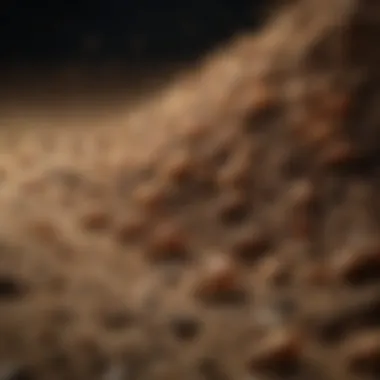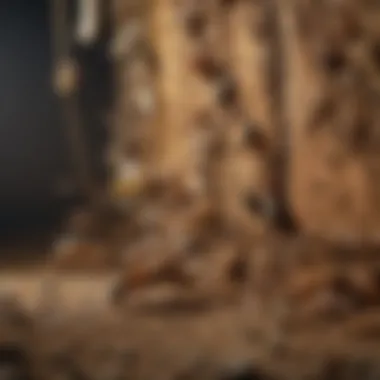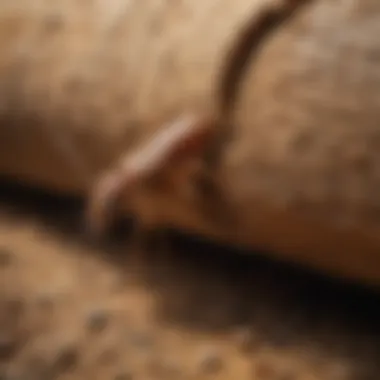Best Treatments for Subterranean Termites Explained


Intro
Subterranean termites pose a significant threat to structures and crops across various regions. Understanding these pests is crucial for farmers, agricultural professionals, and homeowners. The dynamics of termite activity, their feeding habits, and the potential damage they can cause are central to effective treatment and prevention. This article delves into the best treatments available today, offering insights into their effectiveness and practical application.
Current Trends in Agriculture and Horticulture
Overview of Recent Innovations
With the growing concern over pest management, recent innovations have emerged in how we treat subterranean termites. Biological controls are becoming popular. For example, nematodes are utilized as a natural predator to combat these pests. This method is gaining traction due to its reduced environmental impacts compared to traditional chemical treatments. New formulations of pesticides also now offer targeted action, which minimizes collateral damage to beneficial insects.
Sustainable Practices Gaining Popularity
Farmers and homeowners increasingly recognize the benefits of sustainable practices. Integrated pest management (IPM) is a holistic approach combining various strategies such as monitoring, biological control, and selective pesticide application. By applying IPM, practitioners seek to manage termite populations effectively without over-reliance on chemicals. Furthermore, maintaining adequate moisture control in soil can deter termite activity, making it a preventive measure worth adopting.
Essential Farming Techniques
Soil Health Management
Healthy soil represents a key factor in preventing subterranean termite infestations. Regular soil testing provides valuable insights into nutrient levels and pH balance. Keeping soil healthy through the addition of organic matter can create unfavorable conditions for termites, as they favor moist and nutrient-rich environments.
Pest and Disease Control Strategies
Effective control strategies include a combination of monitoring and appropriate treatment applications. Using bait systems can be an intelligent way to manage termite populations. These bait systems slowly release active ingredients that termites consume. This leads to a gradual decline in their overall population. Home inspection is vital; regular checks for signs of termite activity help in timely interventions.
Tools and Technology in Farming
Overview of Advanced Farming Tools
Technology plays a pivotal role in modern pest control. Thermal imaging sensors can detect moisture and heat anomalies in structures, indicative of termite activity. This non-invasive method allows for targeted treatment applications, reducing unnecessary chemical usage.
Case Studies on the Use of Technology
Real-world examples of technologies reduce termite infestations effectively in specific scenarios. For instance, a study on a cooperative farm found that using acoustic emission detection significantly helped in early termite detection. Farmers who employed this technology reported a decrease in treatment costs and damage.
"Investing in modern pest control technologies not only helps reduce infestations but also supports sustainable agriculture practices."
Understanding Subterranean Termites
Understanding subterranean termites is crucial for effective pest management and prevention strategies. These termites are known for their destructive behavior, targeting wooden structures, which can lead to severe property damage. By grasping their biology, behavior, and environmental preferences, stakeholders can tailor their approach to treatment and prevention effectively.
Biology and Behavior
Physical characteristics of subterranean termites
Subterranean termites exhibit specific physical traits that set them apart from other pests. Most notably, they have a soft, creamy body and are typically less than one inch long. Their color ranges from white to light brown, which allows them to blend in with their environment. This characteristic is beneficial, as it helps them avoid detection by predators. Their bodies are elongated, and they lack the hard shells typical of some insects. This softness makes them vulnerable to desiccation, necessitating their subterranean habitat. Understanding these traits is vital for recognizing them in the wild and developing targeted treatment options.
Life cycle and reproduction
The life cycle of subterranean termites is intricate, consisting of three primary stages: egg, nymph, and adult. After mating, a queen can lay thousands of eggs annually. This prolific reproduction is a key factor contributing to their rapid population growth and potential for large-scale infestations. The presence of colonies growing quickly underlines why a prompt response is necessary upon detecting a termite issue. However, the longevity of the lifespan, which can reach years, adds to the complexity of control strategies. Knowing this life cycle can help in timing treatment applications effectively.
Feeding habits and wood damage


Subterranean termites are notorious for their wood-eating capabilities. They primarily feed on cellulose found in wood and plant matter, which leads to structural damage. Their feeding habits can result in considerable economic loss since these insects can compromise buildings, furniture, and other wooden elements before their presence is realized. The unique aspect of these feeding mechanics is that they can hollow out wood, leaving only a thin surface behind. This behavior is detrimental, as it can be difficult to assess the extent of the damage until it's too late. Awareness of their feeding habits equips stakeholders to take preventative measures early.
Geographical Distribution
Regions most affected by subterranean termites
Subterranean termites are most prevalent in warm and humid regions. This includes areas such as the southeastern United States, parts of California, and Hawaii. Their distribution often coincides with climates that provide suitable moisture levels for their survival. Knowing these regions helps homeowners and agricultural professionals understand the risk to their properties and implement proactive measures accordingly. The widespread presence in these areas necessitates local awareness and education on prevention methods.
Environmental conditions promoting infestations
Certain environmental conditions greatly promote subterranean termite infestations. High humidity, moisture-laden wood, and proximity to soil allow these pests to thrive. Subterranean termites build mud tubes to access food sources while retaining moisture. Recognizing these conditions can inform effective prevention strategies. For instance, eliminating standing water and ensuring proper drainage around the property can limit their likelihood of developing into a serious infestation. Understanding these environmental factors not only aids in effective treatment but also enhances proactive prevention.
Signs of Subterranean Termite Infestation
Identifying the signs of subterranean termites is crucial for timely intervention. By recognizing these signs early, homeowners and agricultural professionals can mitigate extensive damage to properties and crops. This section outlines how to detect these pests and assess the damage they cause.
Identifying Infestation
Common indicators of termite activity
Common indicators of termite activity include mud tubes, droppings, and visible damage to wood structures. Mud tubes are particularly significant as they serve as highways for termites traveling to and from their colonies underground. These tubes are built with soil, wood, and saliva, and can be seen near foundations and along wooden structures.
The presence of droppings, resembling small pellets or sawdust, provides additional evidence of infestation. Inspecting wooden elements of homes or fields can reveal these signs. Noticing any ripple effect on walls or ceilings may also signal wood damage caused by termite tunneling.
A key characteristic of these indicators is their ability to suggest termite presence before significant damage occurs. They are beneficial in finding infestations early on, thus making it easier to formulate a response plan. Although some signs may be easily overlooked, anyone aware of the characteristics can quickly act to stop an infestation.
Monitoring techniques for detection
Monitoring techniques for detection include visual inspections, moisture meters, and baiting devices. Visual inspections are the most straightforward approach. Regular checks of the property, especially in at-risk areas, can reveal signs of termites early.
Moisture meters help identify hidden moisture in wood, which attracts termites. Baiting systems can also trap and mark areas of activity by using attractants that entice termites into the trap. These techniques can be seen as complementary when trying to detect an infestation.
A distinct feature of monitoring techniques is their integration potential. Using several methods provides a more accurate assessment of termite activity. While effective, some methods may require specialized knowledge for proper usage. However, they can significantly enhance detection efforts.
Treatment Options for Subterranean Termites
Choosing the right treatment options for subterranean termites is critical. These pests can cause extensive damage to structures, making it essential to understand various methods for managing them. A combination of treatment solutions can yield better results in eradicating termites and preventing future infestations. Each treatment method has unique characteristics and benefits, which can help property owners make informed decisions.
Chemical Treatments
Termiticides and their application
Termiticides are the most widely used chemical treatments for controlling subterranean termites. They are specially formulated to penetrate the soil and establish a protective barrier around properties. The effectiveness of termiticides stems from their ability to kill termites on contact or through ingestion. This characteristic makes them a popular choice in termite management strategies. Moreover, termiticides come in various formulations, such as liquid or foam, providing flexibility in application methods.
One advantage of termiticides is their immediate action against existing termites. However, there are disadvantages too. Continuous chemical exposure can lead to environmental concerns, and there is a risk of resistance developing among termite populations over time. Careful consideration must be given when choosing termiticides to balance efficacy and ecological impact.
Effectiveness and longevity of chemical treatments
The effectiveness and longevity of chemical treatments is a primary concern for property owners. Depending on the type of termiticide used, the duration of protection can vary. Some termiticides can last several years if applied correctly, providing long-term prevention against infestations. The key to their popularity lies in the fact that they offer immediate results while also ensuring prolonged protection.
However, it is important to note that environmental conditions, such as moisture levels and soil type, can affect their effectiveness. In some situations, a single treatment may not suffice. Regular monitoring and reapplication may be necessary, which can contribute to increased costs over time.


Baiting Systems
How baiting systems work
Baiting systems represent a different approach to termite management. These systems use bait stations strategically placed around the property. The bait contains slow-acting insecticides that termites consume and carry back to their colony. Over time, this process leads to colony elimination since the bait eventually reaches the queen and the rest of the termites.
One of the unique features of baiting systems is their minimal impact on non-target organisms and the environment. This characteristic makes them increasingly popular among eco-conscious property owners. Baiting systems also offer long-term monitoring. However, they can take longer to show results compared to chemical treatments, which may not be ideal for emergency situations.
Advantages and limitations of bait systems
The advantages of bait systems are quite notable. They provide targeted control without widespread pesticide application, thus reducing environmental risks. Additionally, bait systems can be less harmful to beneficial insects, which is a significant consideration for those interested in maintaining biodiversity in their gardens or agricultural settings.
Nevertheless, there are limitations. The success of bait systems largely depends on proper placement and monitoring. If not managed well, they may fail to protect the property adequately. Moreover, they often require a longer time to see noticeable results, which may not sit well with property owners seeking immediate relief from termite activity.
Physical Barriers
Types of physical barriers
Physical barriers serve as an essential line of defense against subterranean termites. These barriers can include steel mesh, concrete, or other materials designed to prevent termite entry. The key characteristic of physical barriers is their ability to stop termites from invading structures without relying on chemicals.
One benefit of physical barriers is their durability. Once installed, they require little maintenance and provide lifelong protection. On the downside, the installation can be labor-intensive and costly upfront. It’s essential to weigh the long-term benefits against the initial investment when considering this option.
Installation methods and considerations
When it comes to installing physical barriers, there are several factors to consider. The installation must be thorough to ensure effectiveness. Barriers should cover all potential entry points, including crawl spaces and voids in buildings. Proper installation also requires knowledge of local building codes and regulations, which can add complexity to the process.
Another consideration is the existing architecture of the property. Older homes might need specialized approaches to create an effective barrier. While the method can be more costly than other treatments, the long-term peace of mind that comes with sufficient termite prevention may justify the expense.
Integrated Pest Management (IPM)
Concept of IPM in termite control
Integrated Pest Management, or IPM, emphasizes a holistic approach to pest control. Rather than relying on a single treatment method, IPM combines various strategies to effectively manage subterranean termites. This concept promotes a deeper understanding of termite behavior and ecology. Its key advantage lies in minimizing the reliance on chemical solutions, creating a balanced approach to pest control.
IPM is beneficial as it helps in developing a sustainable pest management plan. By integrating monitoring, baiting, and chemical treatments as needed, property owners can tailor their approach based on the specific conditions of their environment. However, successful IPM implementation requires knowledge and persistence, which may not be easily achievable for all homeowners.
Combining treatments for effectiveness
Combining treatments for effectiveness is a fundamental principle of IPM. This strategy allows property owners to use multiple methods concurrently, increasing the likelihood of success in eradicating termite populations. By leveraging the strengths of various treatments, such as chemical barriers and baiting systems, infestations can be managed more efficiently.
The unique feature of this combined approach is its flexibility. Property owners can adapt their pest management strategy based on changing conditions or infestation severity. While combining treatments can increase overall costs, the potential benefits of complete and effective termite control can outweigh the downsides.
"Effective termite management requires understanding, commitment, and often a combination of methods to achieve lasting results."
Preventive Measures
Preventive measures against subterranean termites are crucial for maintaining structural integrity and protecting property from infestation. Understanding and implementing these strategies can save significant costs associated with damage repairs. Prevention is always better than treatment, hence establishing proactive steps can help manage and reduce the risk of termite activity.
Property Maintenance
Examining structural vulnerabilities


One significant aspect of examining structural vulnerabilities is the identification of potential entry points where termites could invade a property. This examination includes checking the foundation, basement, crawl spaces, and other critical areas. By detecting and reinforcing these weak points, homeowners can effectively deter termite invasions. The key characteristic here is the necessity of regular assessments. It is a beneficial choice for preventive measures since a well-maintained structure is less likely to attract termites. The unique feature of this approach is its proactive nature. Frequent checks enable the identification of issues before they escalate into serious infestations. However, it does require a commitment of time and resources for thorough inspections.
Landscaping considerations to deter termites
Landscaping plays a significant role in preventing termite infestations. Key aspects, such as selecting plants that are less attractive to termites, can be extremely helpful. The integration of mulch can also shield the foundation from moisture, which attracts termites. This is a favorable choice as it not only enhances aesthetic appeal but also reduces the risk of infestation. A unique feature of this approach is the potential for creating physical barriers that inhibit termite access. However, care must be taken as some landscaping choices might unintentionally provide nesting sites for termites if not planned properly.
Regular Inspections
Scheduling inspections
Scheduling regular inspections are vital to ensure any early signs of termite activity are detected promptly. Finding a suitable timeframe that works—such as bi-annual checks—ensures thorough monitoring. Regular inspections stand out as they create a consistent baseline for assessing potential problems. This scheduled practice can preempt the severity of infestations, making it a valuable strategy. However, some property owners might overlook their importance, believing that they can skip them once the initial treatment is complete.
Choosing a qualified inspector
Selecting a qualified inspector is essential in guaranteeing thorough evaluations of potential termite infestations. A knowledgeable inspector brings expertise and experience to properly assess all areas of the property. This choice is beneficial because it ensures that all possible trouble spots are checked against termite activity. The unique feature of this importance rests in the assurance it provides to property owners that a professional is monitoring their premises. However, this can come at a higher cost, making it necessary for owners to weigh the benefits against their budget.
Challenges in Treatment Implementation
The challenge of treating subterranean termites is an essential consideration in pest control. Termites are resilient creatures, and their ability to adapt makes treatment implementation complex. Understanding these challenges is vital for homeowners, agricultural professionals, and pest control services. Each component, from resistance to treatments to the impact on non-target organisms, can dictate the effectiveness and sustainability of any termite control strategy.
Resistance to Treatments
Understanding pesticide resistance
Resistance to treatments is an increasingly significant concern for those dealing with subterranean termites. It refers to the ability of termite populations to survive chemical applications that were once effective. This resistance can develop over time as pesticides are applied repeatedly, creating selective pressure on termite colonies. A key characteristic of this resistance is that it often stems from genetic mutations within termite populations. The development of pesticide resistance represents a major barrier in effective pest management. It is crucial to identify resistant populations proactively so that alternative strategies can be devised. The implications of this unique feature can lead to longer infestation periods and increased costs associated with retreatments and enhanced control measures.
Implications for treatment effectiveness
The implications of resistance directly affect treatment effectiveness. When termites become resistant, the products traditionally used may no longer deliver the desired results. This scenario highlights the necessity for diverse pest control approaches in managing subterranean termites. Innovative treatments or combinations may become increasingly critical to ensure success. This shifts the focus toward integrated pest management systems. The unique feature here is that pest resistance can necessitate ongoing research and development of new treatments. While this can seem daunting, it also opens the door to alternative and possibly more effective measures to control pests responsibly.
Non-target Organism Impact
Environmental concerns with chemical treatments
Environmental concerns about chemical treatments are significant, especially given the potential harm they can cause to non-target organisms. The application of certain pesticides can lead to adverse effects on beneficial insects and nearby wildlife. This presents a dual dilemma. On one hand, effective termite management is necessary. On the other hand, ensuring the preservation of ecological balance is also crucial. Many property owners may not consider the potential consequences of their chosen treatment method on local ecosystems. Therefore, understanding the chemical's environmental impact plays an important role in choosing a treatment that is effective without being harmful.
Balancing pest control with ecological responsibility
Balancing pest control with ecological responsibility is a vital aspect of modern pest management strategies. As resistance to traditional chemical treatments heightens, it becomes even more essential to explore sustainable alternatives. Integrating biological controls along with conventional methods can significantly minimize the adverse impacts on non-target organisms. This multifaceted approach not only keeps properties safe but also contributes to environmental health. This balance requires thoughtful consideration of treatment choices and careful planning of pest management programs. By considering ecological impact, pest control becomes more than just dealing with termites; it evolves into a commitment to creating a sustainable living environment.
Closure
In summarizing the complex topic of subterranean termite treatment, it is crucial to recognize the multifaceted approach necessary for effective pest management. Subterranean termites pose significant threats to both residential and agricultural structures, demanding our attention through strategic action and informed decisions. This article provides essential insights into various treatment modalities, blending chemical, physical, and strategic preventive measures.
Importance of a Comprehensive Understanding
Understanding these pests’ biology and behavior lays the foundation for selecting appropriate treatment options. The effectiveness of any intervention hinges upon accurate identification and assessment of termite activity. Before implementing any solution, homeowners and agricultural professionals need to evaluate potential structural vulnerabilities.
Additionally, integrating Integrated Pest Management (IPM) not only optimizes treatment efficacy but also respects environmental considerations. Engaging in regular inspections and maintenance confirms the ongoing health of one's property. When individuals are proactive, they minimize the chance of severe infestations. This builds a more sustainable approach to pest control.
Benefits of Knowledge and Preparedness
- Timely Action: Early detection reduces structural damage and costs associated with extermination.
- Diverse Treatment Options: Understanding the pros and cons of methods such as chemical treatment or baiting systems allows for tailored solutions.
- Environmental Responsibility: Awareness of non-target organisms and potential environmental effects guarantees that pest control efforts do not inadvertently harm beneficial species.
Investing effort into understanding subterranean termites and their management benefits everyone impacted. Better strategies ensure agricultural viability and create safer living spaces.
"Knowledge is a key element in facing the threat of subterranean termites with confidence and capability."
Ultimately, as we synthesize the findings presented in this guide, it is apparent that a holistic approach is not just beneficial but necessary for effective termite control. By employing informed strategies and remaining diligent, one can significantly reduce the likelihood of infestation and damage.



